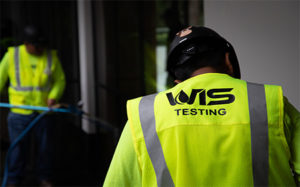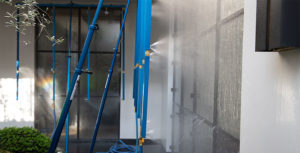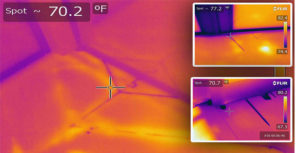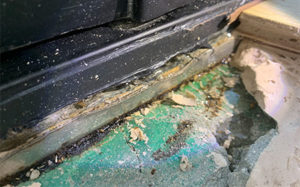ASTM E1105 Water Testing Project
Our team was called out to Los Angeles to investigate stains in the wood flooring throughout the residence. After our initial investigation we noticed that the stains may have been directly related to water intrusion from the product. Therefore, for us, the go-to test for this project would be the ASTM E1105 Water Testing method.
To clarify, this building is a brand new construction residential property approximately 25,000 square feet. In other words, the building was rather large with over 150 windows and doors throughout. Typically, the ASTM E1105 Water Testing would require a sample of windows to test, which was what occurred.
The E1105 water test is common
Needless to say, the ASTM E1105 Water Testing method is a fairy straightforward test to apply with proven results. While the test is typically administered in two parts, we only used one of the parts. For example, the first part of this test is the water spray part, administered from the exterior. At the same time, there is an interior air chamber installed which creates a differential pressure. This pressure effectively pulls water through the assembly. With this test, we only administered the water portion as directed by the Laboratory who rated this window/door product initially.
Once the test was underway, we noticed quickly that just about 100% of all products tested leaked. More than that, the leaking while some visible, the majority of the leaks were not. That is to say, not all leaks were easily visible to the naked eye or without the use of an infrared camera. Furthermore, the use of an infrared camera is not a typical procedure when it comes to “standardized water testing”, like AAMA / ASTM. At least not in the commercial world of testing.
Leaking is still… leaking
Nevertheless, leaking is still leaking. To make matters worse, the water infiltration was happening under a wood floor, and when that happens there is an increased risk and potential for the wood to be damaged. Destructive testing is almost always required when troubleshooting forensic issues at som point in time, and although the use of non-destructive equipment is very helpful, it is still recommended to do some destructive investigation when possible. In this particular instance, a new construction house with interior finishes in place, the client elected to forgo any destructive testing which limited the investigation.
In one of the images you can see an area which was “cut out”, not by us, but by a flooring company. The reason for the work was unknown but it did lend itself to a complete view of what would have otherwise been hidden. That is the door/window pan(s) that appeared to be taking in water and subsequently not draining out but rather into the house. The use of infrared camera images aided test personnel in finding water intrusion at other similar locations that showed similar leak patterns.




